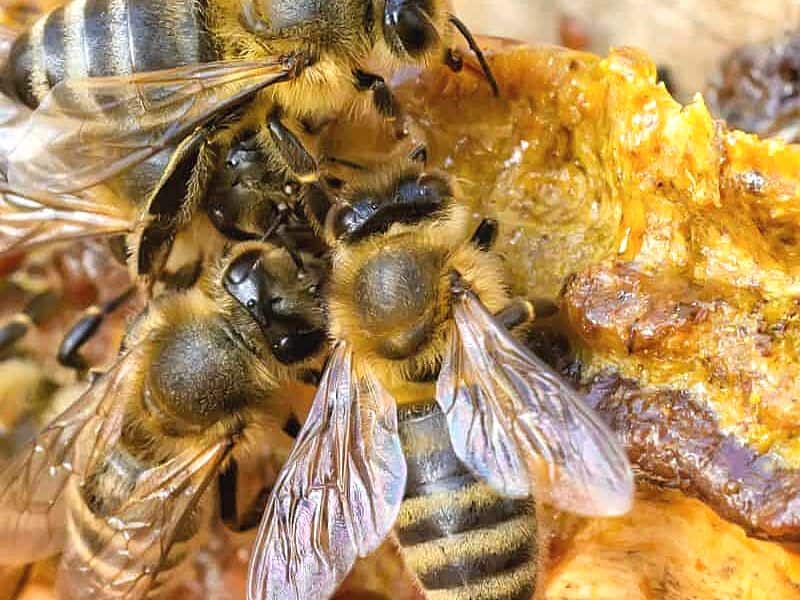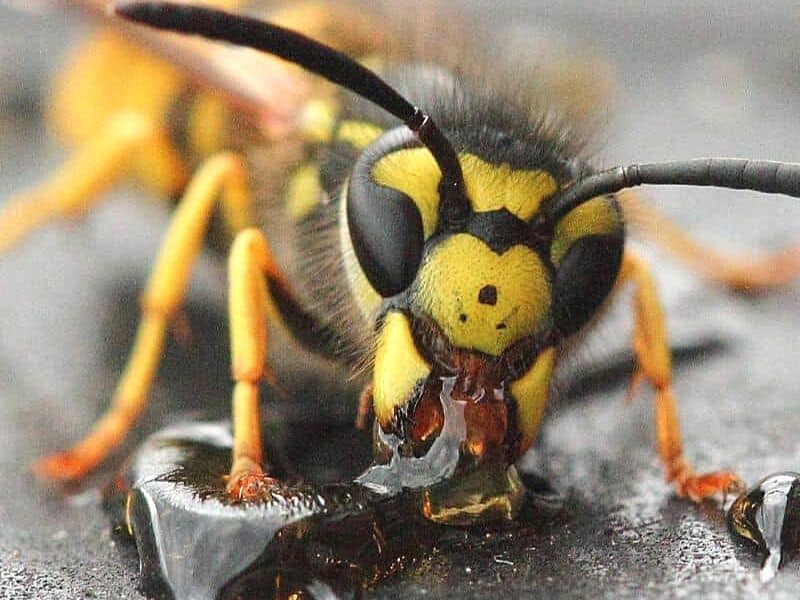Do Bees Have Teeth?
Honey bees are amazing insects that have specialized body parts – but what about teeth. Do bees have teeth? Perhaps they do – in a fashion. Nature gives the bees the tools they need to survive and prosper in their world. Still, since bees usually sting for defense – it is not off the wall for us to wonder if they have a need to bite as well.

Honey bee anatomy is truly amazing. From the pollen basket that carries plant pollen – to the honey stomach or crop that brings back nectar- each part is designed for the given function.
Bee Teeth and Mandibles
Well, bees do have teeth – of a sort. They have body parts that function as teeth – their mandibles.
Now of course, they look very different than the pearly whites of humans. And, bees don’t have to carry around a toothbrush or visit the dentist. Lucky bees.
The mandibles are found in the head section of insects. To outward appearances, we would call these pincher-like structures jaws.
On the end of the mandibles are several ridged formations that protrude upward – they are normally classified as the bee’s teeth.
Most insects have toothed mandibles that are used for biting, chewing and holding food. But, they don’t all have the same type of toothed mandibles.

Honey Bee Mandibles
Many living creatures have a moveable jaw. Honey bees however have 2 moveable jaws. In addition to moving up and down in a chewing movement, bee mandibles also move in and out.
This offers them unparalleled precision in their tasks. When first emerging from their brood cell, mandibles help open the cell and allow release.
They are also used to clean cells and remove debris. This prepares the cell for the queen bee to fulfill her role of egg laying.
In addition to cleaning up the brood nest, worker bees use their mandibles and teeth to polish the hive with propolis. They also use mouth parts for shaping honeycomb into hexagon cells.
In honey bee colonies, the worker bees get the most use out of their toothed mandibles. But, drones (male bees) and queens have them too. Those of the drone bee are small because they do no real work.
However, the queen bee has large mandibles because of her hive tasks. When she is ready to emerge from her queen cell – she chews away the wax end and proceeds to destroy her rivals.
How Bees Use Their Teeth
You won’t find a bee with a mouthful of teeth but you can find many different types of toothed mandibles. They are used in many ways by a variety of insects (not just honey bees).
- nest building
- gathering food
- protecting proboscis
- biting and defense

Nest Building
The wide variety of nesting habits and food sources for bees contributes to the idea the bees must have teeth. Just look at the differences between wasps and honey bees, two closely related insects.
Honey bees create the structures within a beehive by producing sheets of beeswax.Certainly, the thousands of wax cells must be shaped and formed with more than just 3 pair of bee legs.
Most wasps and the closely related hornets build paper nests that are grey. They are made of plant materials (bark etc). that is collected by pulling it off a living tree or shrub.
Then the material is carried back to the nest site and chewed to make a paper-like pulp using saliva.
The female leafcutter bee has 4 noticeable teeth that are used to cut plant material for their nest. Insects that gather resin use their teeth to scrape the plant secretions off the tree. Female carpenter bees use mandibles and teeth to bore holes in wood and create their homes.
Gathering Food
Honey bees use these teeth-like mandibles through out their lives. In the field, workers sometimes need to bite flower parts to access the nectar or pollen.
Bumble bees are larger and stronger. They often bite open fruits – such as blueberries – to access the sweet liquid inside.
Wasps and other predator insects use their teeth to kill prey and tear about insects. Unfortunately, this is often honey bees. The diet of the bee or wasp in question plays a role in the type of mouth parts that will have.

Protect Proboscis
The proboscis is a straw like structure that is made up of several mouth parts. It is used to suck up liquid nectar and is a very important part of bee life. But, it is delicate. The mandible of the bee folds over the proboscis when not in use and protects it.
Defense
Have you ever been bitten by a bee? In the case of honey bees, they do not bite but honey bees will sting. Most insects that defend themselves against humans use a stinger instead of teeth. But, there are insects that can truly bite.
In insects, the size and number of teeth on the end of the mandibles is related to the task. Sometimes they are rounded but some bees have sharp teeth.
Those that rely on a bite instead of a stinger for defense, have stronger, sharper teeth. This can result in a painful bite for you even from little bee teeth.
FAQs
No, honey bees do not use their mandibles to bite humans.
While honey bee mandibles serve analogous functions to human teeth, they differ significantly in structure and purpose. Honey bee mandibles are specialized mouthparts adapted for special tasks.
Honey bees use their mandibles to gather, manipulate, and apply bee propolis within the hive.
Final Thoughts
Bee teeth or mandibles – call them what you will. However, they serve the function of chewing and shaping material in some of the same ways as human teeth. Yes, these specialized mouth parts are used in many different ways that the consumption of food material.

